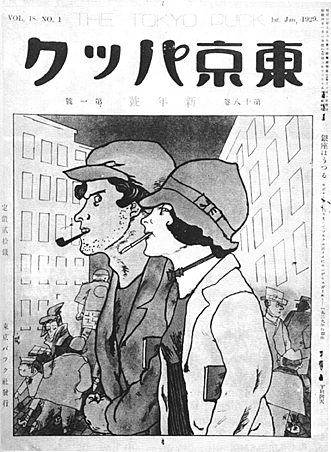
"Changing Ginza."Tokyo Puck, January 1929
For many conservative social critics, the idea of the independently-spirited "modern girl" who worked in the cafés, flaunted new fashions, or cruised the Ginza (with or without her "modern boy" counterpart) represented a threat to political and social order. As an urban phenomenon (hyped beyond its reality to be sure), moga-mobo were often associated with a vision of unruly social masses motivated by labor activism and socialist/communist dogma. They were also perceived as snubbing traditional social norms and gender roles. Indeed, some critics pointed out that 1920s and 30s young urban women were becoming more "masculinized" while young urban men were affecting dandified or "feminized" traits. Foreign influences--including American popular and consumer culture--were often blamed by such critics for this weakening of traditional Japanese national spirit.
Here we have the front page of the journal Tokyo Puck making a connection between Ginza-cruising moga-mobo and supposed dangerous political and social influences. The caption reads: "After moga-mobo, Marx-boy and Engels-girl."